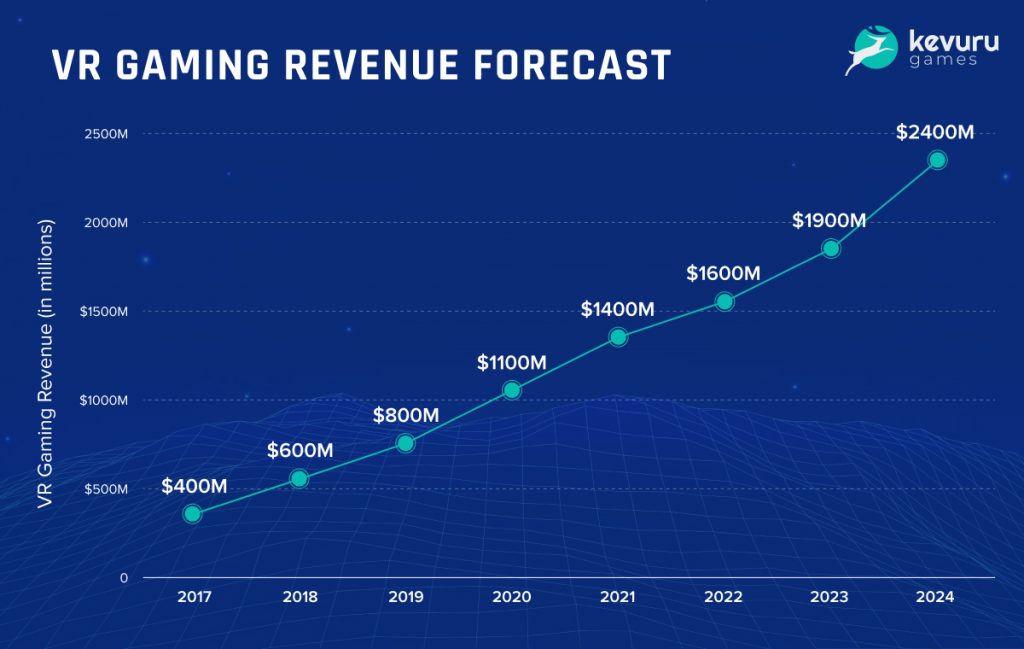Along with how to build augmented reality, virtual reality is one of the most innovative technologies that allows you to fully immerse yourself in the chosen environment. Of course, the gaming industry takes center stage – Statista says there are 171 million VR players worldwide, and the VR market size was $12.13 billion as of 2022. The only thing that slows down the total distribution of VR is the price – this is the main barrier to adaptation named by 55% of the players surveyed by YouGov.
However, the growth of VR game development services continues. The market is expected to reach $2.4 billion by 2024, developers continue to release VR games, and don’t forget other industries looking to embrace VR. Global spending on AR and VR technology is expected to rise from $12 billion in 2020 to $73 billion in 2024, therefore, this technology must be reckoned with and harnessed while the niche is still relatively free.
But how much does it cost to develop a VR app? Is the investment worth it? Will it bring profit, will the development work off? Let’s find out for sure.
Virtual Reality – Why So Popular?
What is so exciting about virtual reality? Well, first of all, here’s the definition.
Virtual reality is a digital reality that uses special technical means to influence the human senses, mainly sight and hearing.
Unlike augmented reality, virtual reality doesn’t overlay a separate digital object on top of the real world. It is a separate digital world. Therefore, to immerse yourself in VR, one smartphone is not enough; you need special equipment – virtual reality glasses or helmets.
The advantages of VR in terms of entertainment are undeniable. Full immersion in the game as if you are the main character instead of the standard contemplation of your characters on the screens gives a completely different feeling. Virtual games capture completely, they actually and unambiguously transfer the player to the virtual world. This is the next level of gaming experience that the leading players in the industry are striving for.
The prospects for VR gaming are also clear from a financial point of view, which can be deduced from the following graph.

In addition to games, VR is actively used in other areas. For example, virtual meetings, excursions, educational VR games or events have long ceased to be something extraordinary. Another thing is that they are still far from becoming a routine for most people. But it’s only a matter of time.
Factors That Affect Virtual Reality Mobile App Development Cost
As with any other application or game, the cost is primarily dictated by its complexity. In turn, complexity can be divided into 3 key components:
- Game content: graphics, mechanics, interface.
- Development: tools, software, SDKs, frameworks.
- Platform: mobile devices, PC, console, or cross-platform option.
Determining How Much Your VR App Will Actually Cost
Complexity is directly related to development time. On average, a VR application can be developed in a year, but who needs such average estimates, right?
- The simplest VR app or game can take anywhere from a month to two months and cost from $20,000.
- A VR project of medium complexity, such as an online store with VR capabilities, will take up to 6 months and cost from $30,000.
- Complex games or large-scale VR projects, for example, for tourism or medicine, will take a year or more and cost from $100,000.
The first two options can be covered by a team of 2 to 5 VR experts. The latter, however, will require at least 10 specialists.
An important aspect of the cost will be the choice of a VR platform. The most popular are:
- HTC Vive (works with PC)
- Oculus Rift (works with PC)
- PlayStation VR (works with PS)
- Google Cardboard (works with Android and iOS)
- Google Daydream (works with the latest models of Android)
However, in fact, it all comes down to timing – the more complex the application and the longer the development takes, the higher the price.
Top Factors Determining VR App Development Time
The duration of development is of great importance because technologies are developing very quickly and what was relevant a year ago now already looks outdated. Considering VR development, the key factors influencing and its duration are classic:
- Request accuracy. The more information you provide to developers, the faster they can get down to business. If there are gaps in your request, the team will have to do additional research, test different options, create prototypes, and this will significantly delay development.
- Team size. The developer company usually forms a team itself, and the speed of development will depend on the number of people. If they can’t allocate enough developers, the work will be slower.
- Application complexity. Directly related to the previous one, this point significantly affects the speed of development, since with a fixed team, an increase in the complexity of the product will mean an increase in the timing of its creation.
Other Factors That Impact the Cost of the VR App Development
Be aware of the difference in developer rates in various parts of the world. For example, in the United States, Canada, and Australia, you will see the highest rates – from $50 per hour and more. Lower prices can be found in Eastern Europe – from $20 per hour, while this does not affect the quality in any way.
So how much does it cost to create a VR app? In fact, their cost is only slightly different from the standard rates for creating applications due to the use of special tools. You can see that the price range is huge, from $20,000 to $100,000 and more, so it makes no sense to try to calculate the budget without first having an idea of what kind of VR application you need.
The easiest and most legitimate way to find out the approximate cost of your future VR application is to request an estimate from the company with which you plan to cooperate. At Kevuru Games, we provide project quote answers within a day and offer optimal collaboration options depending on the type and complexity of your project. Feel free to contact us to find out how much your VR application will cost you.

What is the Process of Creating a VR App?
Having an approximate answer to the question “how much does it cost to make a VR app?” (or after receiving a more detailed estimate from us) you may be interested in how the development of a VR application is going in general. Are there any special features or differences from the classic app development pipeline? In fact, no, the steps are no different from developing any other application:
- Requirements analysis. Based on the requirements you provided for the future VR application or game, the developers analyze the market and form the optimal solution. You may have heard of this stage as pre-production.
- Working on the application. Also known as production, this stage includes designing your application in accordance with its specifics and programming itself, that is, the creation of code.
- Verification and release. Once an application is created, it undergoes various types of testing to make sure it works correctly. The developers also do some final polishing to get the app ready for release.
However, there are also obvious differences. VR games or applications cannot be perceived without an additional device – glasses or a helmet. Therefore, when developing a VR project, first of all, you need to start with the hardware and understand what device you are aiming at.
The most common environments for developing VR games are Unity and Unreal. Unity is considered more versatile, faster, and easier due to the presence of a large number of intuitive tools and the ability to cover almost all known helmets with multi-platform support. If you are targeting VR development for Cardboard and Daydream, then the Google VR SDK is your choice.
Dive Deeper:
✔ Best Game Engines of 2022: Pros, Cons, and Top Picks for Different Types of Games
There are also certain unspoken rules regarding the design of VR games:
- Simple controls. A VR game should offer the player the most simple and intuitive controls, understandable and accessible even to those who first come across VR.
- Short sessions. VR games have a very intense effect on the psyche, so it is important to maintain a balance and give the player the opportunity to relax.
- Content and battery life balance. VR devices consume a lot of energy, and the more resource-intensive the game is, the faster it will drain the battery.
- No delay. The reaction of devices to the movements of the player must be instantaneous, otherwise, the delay will ruin the entire gaming experience.
- First-person point of view. Although there are other options, it is the first-person view that gives the player the maximum immersion in the game world and the opportunity to feel like the main character.
Did you know? Performance is often the main issue in VR games. Maintaining VR frame rates is extremely difficult, even on the recommended hardware. Ideally, the game should be optimized for 60 fps and have low latency. With most of today’s hardware, it’s quite challenging so far.
Popular VR Games Released in 2023
Horizon Call of the Mountain
Platform: Playstation VR 2
Release: February 22, 2023
One of the best VR PC games based in the Horizon universe created by the Dutch company Guerrilla Games, Call of the Mountain puts the player in the role of a former Shadow Carja warrior named Ryas. The gameplay is horizontal and vertical exploration of territories and battles with machines familiar to players from the games Horizon Zero Dawn and Horizon Forbidden West.
Resident Evil Village
Platform: Playstation VR 2
Release: February 22, 2023
The Playstation VR 2 version of the acclaimed 2021 survival horror game by Capcom gives the player the ability to fight with two weapons. PSVR 2 also offers players advanced sensations such as haptic feedback and vibration when the character is pushed or attacked, bringing a whole new gaming experience and level of immersion.
Resident Evil 4
Platform: Playstation VR 2
Release: March 24, 2023
Capcom’s Resident Evil 4 remake, with its release on the verge, will support Playstation VR 2. There is no exact information whether the entire game will be available in VR or only certain content, but the opportunity to immerse themselves first-hand in the terrifying atmosphere of a village with mutated residents, even if only as a short episode, incredibly inspires fans of the series.
FAQ
How to choose the right virtual reality mobile app developer?
When choosing a company to develop your VR application, pay attention to those who have relevant experience. Developers must have an appropriate portfolio of VR projects. It is also a good option to study the reviews of previous clients regarding cooperation with the company on VR applications.
What is the approximate cost of developing VR games?
Depending on the complexity of a VR game, the cost to earn it can range from $20,000 for elementary games to $100,000 or more for more complex titles.
Are VR games free?
There are different options for VR games, some are paid, and some are free. Players are free to choose whether they are willing to pay or get by with the free versions as they see fit.









